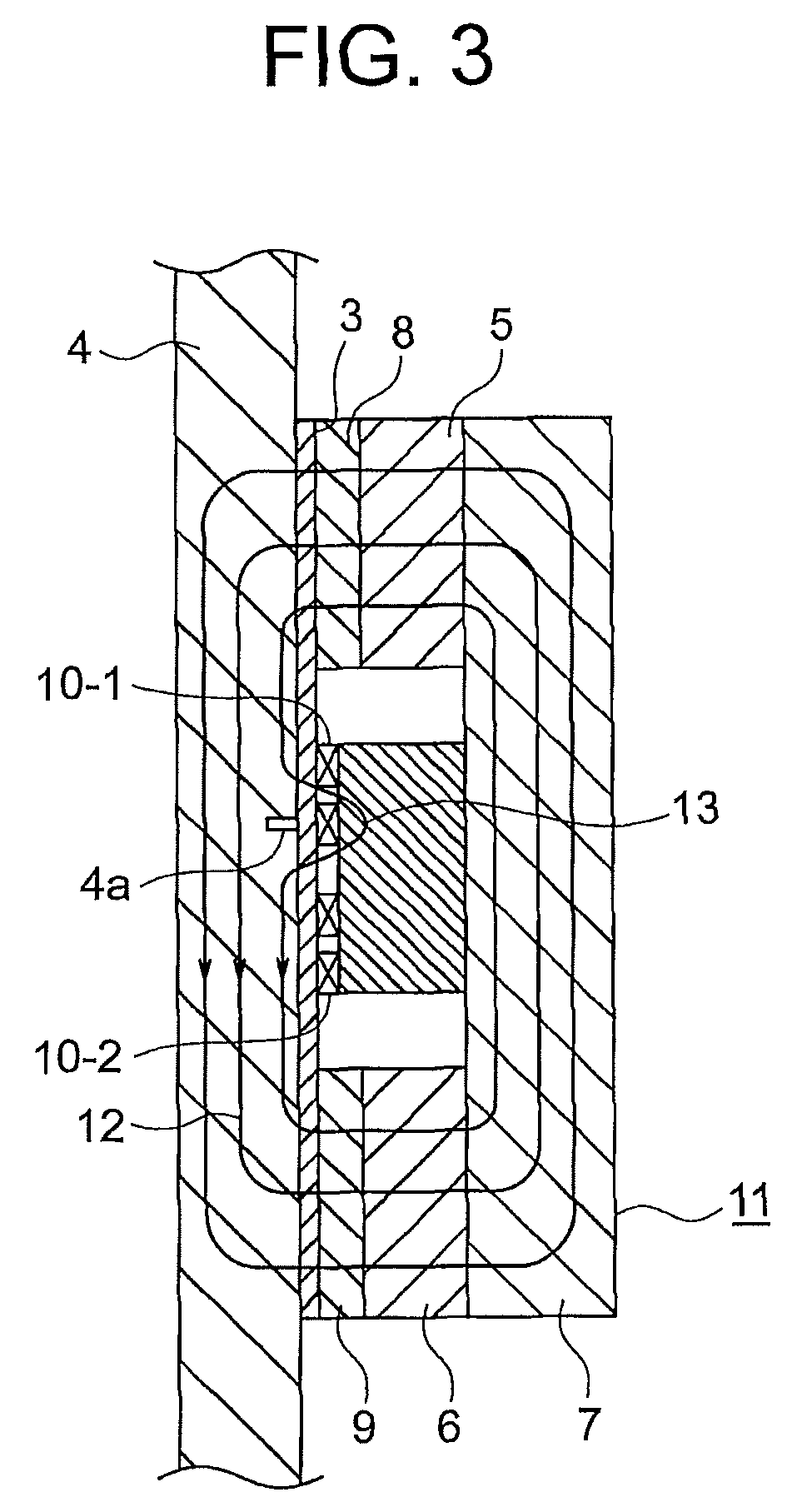Wire rope flaw detection device
a flaw detection and wire rope technology, applied in the direction of material magnetic variables, lifters, transportation and packaging, etc., can solve the problem of leakage flux occurring in the periphery of a damaged part, and achieve the effect of amplifying the peak of induced voltage and improving the s/n ratio more positively
- Summary
- Abstract
- Description
- Claims
- Application Information
AI Technical Summary
Benefits of technology
Problems solved by technology
Method used
Image
Examples
first embodiment
[0026]FIG. 1 is a perspective view for illustrating a probe of a wire rope flaw detector according to a first embodiment of the present invention, and FIG. 2 is a perspective view for illustrating the probe by decomposing a part of the probe of FIG. 1. In the figures, a case 1 includes a case main body 2 and a cover 3 configured to cover the case main body 2 to protect components provided inside the probe. The cover 3 is provided with a cover groove portion 3a having a U-shaped section. A wire rope 4 (FIG. 3) is guided to an inside of the cover groove portion 3a, and is moved relatively with respect to the probe while kept in contact with the cover 3.
[0027]The case main body 2 includes a first permanent magnet 5, a second permanent magnet 6, a back yoke 7, a first pole piece 8, a second pole piece 9, a first search coil 10-1, and a second search coil 10-2. The first permanent magnet 5 and the second permanent magnet 6 are arranged with an interval so as to be spaced apart from each ...
second embodiment
[0044]Next, FIG. 6 is a configuration diagram for illustrating a main part of a wire rope flaw detector according to a second embodiment of the present invention. The specifications of components of the probe for magnetizing the wire rope 4, namely, the first permanent magnet 5, the second permanent magnet 6, the back yoke 7, the first pole piece 8, and the second pole piece 9, are the same as those of the first embodiment.
[0045]The second embodiment is different from the first embodiment in the signal processing method. In this embodiment, the first search coil 10-1 and the second search coil 10-2 are connected to each other in series. A difference between a potential at one end of the first search coil 10-1 and a potential at one of the second search coil 10-2 is A / D-converted in the subsequent stage to be stored in the FIFO buffer of the control unit 21 as output that combines the two search coils 10-1 and 10-2.
[0046]FIG. 7 is an explanatory diagram for illustrating the waveform ...
third embodiment
[0095]Next, FIG. 10 is a configuration diagram for illustrating a main part of a wire rope flaw detector according to a third embodiment of the present invention, and FIG. 11 is an explanatory diagram for illustrating the waveform processing method performed by the control unit 21 of FIG. 10. This embodiment is achieved by generalizing the superimposition of signals described in the second embodiment with the number of search coils being set to m (m is an integer equal to or larger than 3). That is, first to m-th search coils 10-1 to 10-m are arranged in the probe at a regular interval P.
[0096]Those search coils 10-1 to 10-m are connected to one another in series, and generate m peak waveforms while one damaged part 4a passes through the probe. The peak is emphasized by superimposing those peaks m−1 times with an interval of the time period τ. Now, assuming that all the search coils 10-1 to 10-m are wound in the same direction and connected to one another in an in-phase direction, i...
PUM
| Property | Measurement | Unit |
|---|---|---|
| magnetic flux | aaaaa | aaaaa |
| voltages | aaaaa | aaaaa |
| voltage | aaaaa | aaaaa |
Abstract
Description
Claims
Application Information
 Login to View More
Login to View More - R&D
- Intellectual Property
- Life Sciences
- Materials
- Tech Scout
- Unparalleled Data Quality
- Higher Quality Content
- 60% Fewer Hallucinations
Browse by: Latest US Patents, China's latest patents, Technical Efficacy Thesaurus, Application Domain, Technology Topic, Popular Technical Reports.
© 2025 PatSnap. All rights reserved.Legal|Privacy policy|Modern Slavery Act Transparency Statement|Sitemap|About US| Contact US: help@patsnap.com



